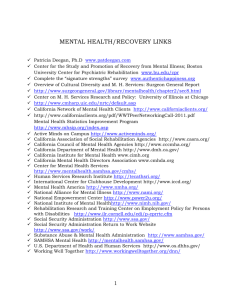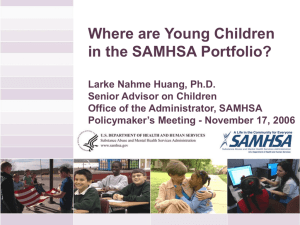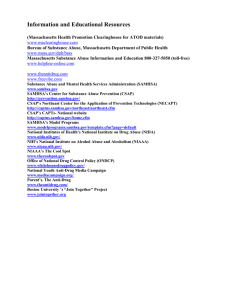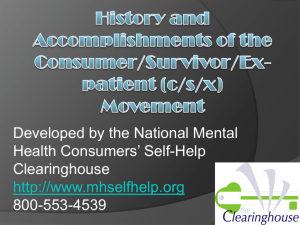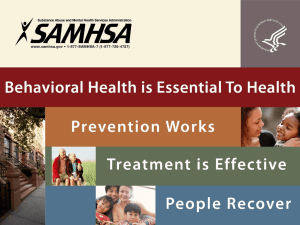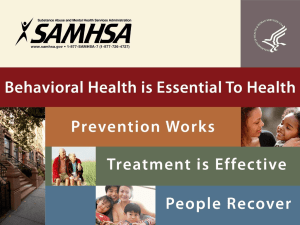challenges and opportunities in a changing health care environment
advertisement
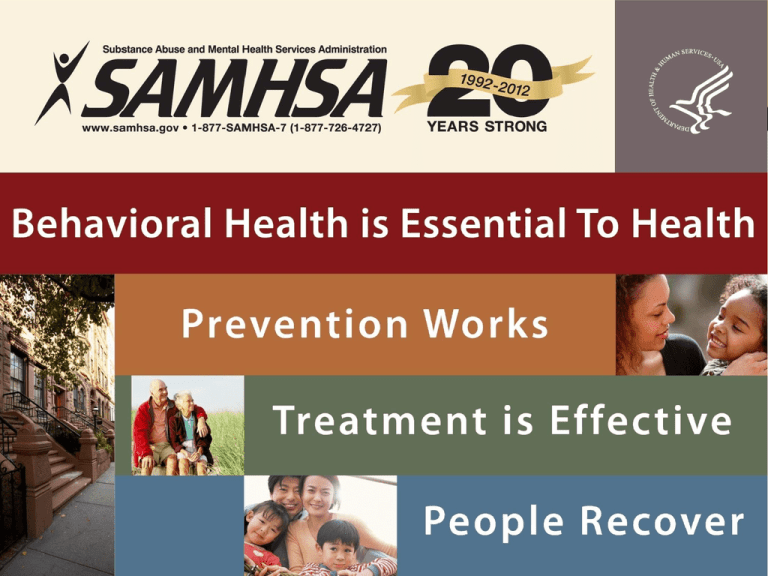
1 2 ADVANCING BEHAVIORAL HEALTH: CHALLENGES AND OPPORTUNITIES IN A CHANGING HEALTH CARE ENVIRONMENT Pamela S. Hyde, J.D. Administrator Substance Abuse and Mental Health Services Administration UMass Medical School Psychiatry Research Day Worcester, MA • April 29, 2013 TODAY’S DISCUSSION 3 1 CHANGING HEALTH CARE ENVIRONMENT 2 3 BEHAVIORAL HEALTH AS PUBLIC HEALTH SAMHSA’S STRATEGIC INITIATIVES CHANGING HEALTH CARE ENVIRONMENT 4 Prevention/Wellness Rather Than Illness Behavioral Health is Essential to Health Quality Rather Than Quantity – saving costs through better care rather than less care Inclusive – Everyone’s Eligible for Something Public Payers’ Roles Changing Implications for State’s Role WHY BEHAVIORAL HEALTH MATTERS TO PUBLIC HEALTH – 1 5 BH Affects Most Americans • Half will meet criteria for MI or substance abuse • Half know someone in recovery from addiction (23 M +) • One in four Americans will experience mental illness Increases Risks for/Co-Exists with Other Diseases, Yet is Preventable • HIV/AIDS, STDs, diabetes, cardiovascular disease, obesity, asthma, hypertension • More adverse childhood experiences (ACEs) = more health/BH conditions in adulthood • Half of adult mental illness begins before age 14 and threequarters before age 24 PREVALENCE OF BH CO-MORBIDITIES (MEDICAID-ONLY BENEFICIARIES W/DISABILITIES) 6 Asthma and/or COPD Congestive Heart Failure Coronary Heart Disease 23.8% 76.2% 30.1% 69.9% 26.3% 73.7% Diabetes 32.1% 67.9% Hypertension 31.4% 68.6% No Behavioral Health Problem With 1 or More Behavioral Health Problem Boyd, C., Clark, R., Leff, B., Richards, T., Weiss, C., Wolff, J. (2011, August). Clarifying Multimorbidity for Medicaid Programs to Improve Targeting and Delivering Clinical Services. Presented to SAMHSA, Rockville, MD. WHY BEHAVIORAL HEALTH MATTERS TO PUBLIC HEALTH - 2 7 High Impact on Health Systems – Practice and Costs • ~ ¼ of pediatric visits and community hospital stays • ~ 1/5 of ER visits involve illicit drugs (21 percent) or alcohol (19 percent) • 2010: Medicare spent 5 x more on beneficiaries age 65+ w/SMI & SUDs than similar beneficiaries w/out these diagnoses • 2010: Of Medicare beneficiaries w/out SMI, 17 percent were hospitalized; 46 percent of those w/SMI diagnosis; 88 percent of those with SMI/SUDs • One of 5 top diagnoses in 30-day readmissions • 22 percent of Medicare beneficiaries age 65+ w/ SMI compared to 13 percent of those w/out SMI • Co-occurring SMI/SUDs – 34 percent rehospitalized w/in 30 days MEDICARE BENEFICIARES AGE 65+ WITH SMI AND SUD HAD SIGNIFICANTLY HIGHER MEDICARE SPENDING 8 BH CO-MORBIDITIES: IMPACT ON COSTS (MEDICAID-ONLY BENEFICIARIES W/ DISABILITIES) 9 Boyd, C., Clark, R., Leff, B., Richards, T., Weiss, C., Wolff, J. (2011, August). Clarifying Multimorbidity for Medicaid Programs to Improve Targeting and Delivering Clinical Services. Presented to SAMHSA, Rockville, MD. WHY BEHAVIORAL HEALTH MATTERS TO PUBLIC HEALTH - 3 10 High # BH-Related Premature Deaths/Preventable Illnesses • Persons w/BH conditions die 8+ years younger, mostly from preventable health issues • Half of all tobacco deaths occur among those w/BH conditions • More deaths from suicide than HIV/AIDS and traffic accidents combined; plus breast cancer for all BH-related deaths Study out of Germany using Composite International Diagnostic Interview and DSM-IV • Much higher annualized death rates for women: 4.6-fold ↑ for females and 1.9-fold ↑ for males compared to age/gender-specific general pop • Mean age of death 20 years ↓ for both genders • Inpatient treatment had no impact on premature mortality WHY BEHAVIORAL HEALTH MATTERS TO PUBLIC HEALTH - 4 11 High Impact of Disparities (race, gender, ethnicity, LGBT, poverty) and Social Issues/Costs (homelessness, jails, child welfare) • Most homeless and jailed individuals have BH needs; relatively few receive treatment; most are in or released to the community • LGBT population – elevated rates of tobacco use, certain cancers, depression and suicide deaths/attempts • Majority of foster children have drug-involved parents • Ethnic minorities more likely to be uninsured, have ↑ rates of certain disorders or incidence (e.g., suicide, drinking) • Persons with BH needs more likely to be uninsured and to “churn,” creating issues within the health delivery system PUBLIC PERCEPTION OF VALUE 12 Public Willing to Pay 40 percent LESS . . . • To avoid mental illnesses (MI) compared to avoiding medical illness, even when MI (including SUDs) are recognized as burdensome* Mental Illnesses Account for 15.4 Percent of Total Burden of Disease** • Yet MH expenditures in U.S. account for only 6.2 percent of total health expenditures • SA expenditures account for only about 1 percent * Source: NICHD, 2011 ** Source: World Health Organization WHY DOES IT MATTER? 13 Public sees social consequences of behavioral health rather than health consequences • Homelessness, gangs, jails, tragedies (e.g., mass casualty shootings), disability, lost productivity, high government costs M/SUDs seen as matter of will instead of diseases or conditions to be prevented, treated and recovered from • Compare diabetes – not just about eating choices Universal Knowledge of First Aid for Health Conditions; Don’t Teach or Know Signs, Symptoms, How to Get Help for MH or SA Issues BH AS A SOCIAL PROBLEM LEADS TO INSUFFICIENT RESPONSES 14 Increased Security & Police Protection Tightened Background Checks & Access to Weapons Legal Control of Perpetrators & Their Treatment More Jail Cells, Shelters, Juvenile Justice Facilities Institutional System & Provider Oversight SAMHSA’S STRATEGIC INITIATIVES 15 1 Prevention 2 Trauma and Justice 3 Military Families 4 Recovery Support 5 Health Reform 6 Health Information Technology 7 Data, Outcomes & Quality 8 Public Awareness & Support STRATEGIC INITIATIVE: PREVENTION 16 Substance Abuse and Mental Illness; Build Emotional & Behavioral Health Suicide Prevention Prevent Underage Drinking Prescription Drug Abuse/Misuse SUICIDE AND MENTAL ILLNESS: TOUGH REALITIES 17 17 50 Percent of Those Who Die By Suicide Had Major Depression – Suicide rate of people with major depression is 8 times that of the general population 90 Percent of Individuals Who Die By Suicide Had a Mental Disorder MISSED OPPORTUNITIES = LIVES LOST 18 77 percent of individuals who die by suicide had visited their primary care doctor within the year 45 percent had visited their primary care doctor within the month 18 percent of elderly patients visited their primary care doctor on same day as their suicide THE QUESTION OF SUICIDE WAS SELDOM RAISED MISSED OPPORTUNITIES = LIVES LOST 19 Individuals Discharged from An Inpatient Unit or Emergency Room Continue to Be at Risk for Suicide • ~10 percent of individuals who died by suicide had been discharged from an ED within previous 60 days • ~ 8.6 percent hospitalized for suicidality are predicted to eventually die by suicide SUICIDE AND SUBSTANCE ABUSE: TOUGH REALITIES 20 20 ~30 % of Deaths by Suicide Involved Alcohol Intoxication At or Above Legal Limit 4 Other Substances Identified in ~10% of Tested Victims • Amphetamines, cocaine, opiates (prescription & heroin), marijuana SURGEON GENERAL’S NATIONAL STRATEGY FOR SUICIDE PREVENTION (NSSP) 21 Annually, 11 M+ Americans Seriously Consider Suicide • 8 M make a plan • 2.5 M > 14 years attempt America Loses ~100 People/24 Hrs • 38,000 in 2010 – not to battles of war, acts of terrorism, mass casualty events, or natural disasters • Half w/ firearms; many w/prescription drugs • America lost more service members to suicide (349) than to combat (229) in 2011 NSSP – Public/Private Partnership • Survivors, practitioners, funders, advocates, standard setters • Released 9/10/12 – World Suicide Prevention Day • Data, standards, screening, high impact models, awareness, high need populations, payment policies • SAMHSA’s Garrett Lee Smith Suicide Prevention Grants PRESCRIPTION DRUGS 22 Most Prevalent Illicit Drug Problem After Marijuana • ~22 M persons initiated nonmedical pain reliever use since 2002 • ~1 in 22 (4.6 percent) reported misuse/abuse of prescription pain relievers (2010 & 2011) • US represents 4.5 percent of world’s population, yet consumes 99 percent of world’s hydrocodone (International Narcotics Control Board) Emergency Room Visits • Non-medical use of ADHD stimulant medications nearly tripled from 5,212 to 15,585 visits; (2005 – 2010) SU Treatment Admissions • Benzodiazepine and narcotic pain reliever abuse ↑ 569.7 percent (2000 to 2010) SOME FAMILY AND FRIENDS AREN’T HELPING 23 Marijuana: ~ 70 percent of 523,000 teens aged 12-14 received the drug for free the last time they used • Over half (55.6-percent) received from friends • Over 10 percent received from someone in their family Prescription Pain Relievers: 54 percent of persons 12 and ↑ who used non-medically received them from a friend or relative for free Alcohol: ~20 percent of the time, parents, guardians, or other adult family members provided alcohol for underage drinkers SAMHSA’s WORK – WITH PARTNERS 24 W/ Office of National Drug Control Policy (ONDCP) – Prescription Drug Prevention Plan W/ ASPE and CMS – Data Analysis W/ FDA, DEA, NIDA – Prescriber Training, Report to Congress, Public Awareness W/ ASTHO – Opioid Overdose Prevention Toolkit W/ ONC and DOJ – Grants to States for Prescription Drug Monitoring Programs (PDMPs) Interoperability with Health Information Exchanges (HIEs) and between States W/ States – Grants for Prevention of Prescription Drug Abuse and Underage Drinking STRATEGIC INITIATIVE: TRAUMA AND JUSTICE 25 Trauma-Informed Care; Trauma-Specific Screening and Services • Common definitions, principles, data • Consolidated technical assistance approach Childhood trauma in Juvenile Justice/Child Welfare Grants for Adult Trauma Screening Brief Interventions – GATSBI • New services research grant program proposed to test new brief intervention (BI) models for women • Screen for trauma and interpersonal violence in emergency rooms, primary care offices, OB/GYN offices; provide BI Court Collaboratives/Early Diversion to Prevent Penetration into Corrections or Judicial Systems BH Impact of Disasters/Tragedies TRAGEDIES Grand Rapids, MI 2011 – 8 Lost Aurora, CO 2012 - 12 Lost Nickel Mines, PA 2007 – 6 Lost 26 Tucson, AZ 2011 – 6 Lost Newtown, CT 2012 – 26 Lost Asher Brown 2010 – 1 Lost 13 yrs old Boston, MA 2013 – 3 Lost Virginia Tech, VA 2007 - 33 Lost Red Lake Band of Chippewa, MN, 2005 – 10 Lost Columbine High School Littleton, CO 1999 - 15 Lost SAMHSA’s DISASTER TECHNICAL ASSISTANCE CENTER (DTAC): NATURAL AND HUMAN-CAUSED DISASTERS 27 Technical Assistance, Training, and Expert Consultation • Review state/local all-hazards disaster BH plans Disaster BH Resources • >1,800 tip sheets, publications, studies, and articles Information Exchange and Knowledge Brokering • Connects those seeking technical assistance w/peers and experts in BH field www.samhsa.gov/dtac ADDITIONAL SAMHSA RESOURCES & WORK 28 www.samhsa.gov www.suicidepreventionlifeline.org www.samhsa.gov/treatment www.disasterdistress.gov Research efforts with Assistant Secretary for Preparedness and Response (ASPR) and NIH THE PRESIDENT’S PLAN: MENTAL HEALTH AS A PUBLIC HEALTH ISSUE 29 Less than half of people w/BH conditions receive the care they need 23 Executive Actions to Reduce Access to Guns and Increase Mental Health Services FY 2014 Budget Mental Health Proposals -- $235 M “We are going to need to work on making access to mental health care as easy as access to a gun.” --President Obama National Dialogue on Mental Health – to be launched this Spring PRESIDENT’S EXECUTIVE ACTIONS ON GUN VIOLENCE – MAJOR IMPLICATIONS FOR BH 30 Among the 23 Executive Actions • No. 17: "Release a letter to health care providers clarifying that no federal law prohibits them from reporting threats of violence to law enforcement authorities.” – January 16: Letter issued by Secretary Sebelius • No. 2: "Address unnecessary legal barriers, particularly relating to the Health Insurance Portability and Accountability Act, that may prevent states from making information available to the background check system.” – Advance Notice of Proposed Rule-Making (ANPRM) – ANPRM available for review at: https://federalregister.gov/a/2013-01073 – Comments can be submitted to: http://www.regulations.gov/ – Comments due June 7, 2013 PROHIBITORS: GUN CONTROL ACT 18 U.S.C. 922(g) & (n) 31 (g)(1) Are Convicted of a Crime Punishable by Imprisonment for a Term Exceeding One Year (g)(2) Are Fugitives From Justice (g)(3) Are Unlawful Users of or Addicted to Any Controlled Substance (g)(4) Have Been Adjudicated as Mental Defectives or Been Committed to a Mental Institution (g)(5) Are Aliens and Are Illegally or Unlawfully in the United States (g)(6) Have Been Discharged From the Armed Forces Under Dishonorable Conditions (g)(7) Have Renounced Their United States Citizenship (g)(8) Are Subject to a Court Order Restraining Them From Committing Domestic Violence (g)(9) Have Been Convicted in Any Court of a Qualifying Misdemeanor Crime of Domestic Violence (n) Are Under Indictment/Information for a Crime Punishable by Imprisonment for a Term Exceeding One Year STRATEGIC INITIATIVE: MILITARY FAMILIES 32 Access to Community-Based BH Care • President’s Executive Order – VA pilots; peers; suicide prevention; quality measures; National Research Action Plan (PTSD, TBI, suicide prevention) • TRICARE – credentialing and service package for current military personnel • State policy academies – 30 + states/territories and DC – National Guard, Reservists, families not otherwise covered Military Culture Training • With HRSA and private partners – National Council/SAAS Promote Emotional Health/Resilience of Veterans, Services Personnel, and Military Families • Programs & evidence-based practices in HHS programs STRATEGIC INITIATIVE: RECOVERY SUPPORT HOME ↑ Permanent Housing HEALTH ↑ Recovery Individuals and Families PURPOSE ↑ Employment/ Education COMMUNITY ↑ Peer/Family/ Recovery Network Supports 33 STRATEGIC INITIATIVE: HEALTH REFORM 34 Essential Health Benefits (EHBs) – Parity Enrollment and Eligibility – Qualified Health Plans (QHPs) Uniform Block Grant Application – TA to States Services, Payment Policies, Quality/Measures • Medicaid (health homes, rules/regs, good & modern services, screening, prevention) • Medicare (duals, partial hospitalization, same day billing) Primary/Behavioral Health Care Integration (PBHCI) HIV/AIDS Prevention and Mental Health Treatment ESSENTIAL HEALTH BENEFITS (EHB) 10 BENEFIT CATEGORIES 35 1. Ambulatory patient services 2. Emergency services 3. Hospitalization 4. Maternity and newborn care 5. Mental health and substance use disorder services, including behavioral health treatment 6. Prescription drugs 7. Rehabilitative and habilitative services and devices 8. Laboratory services 9. Preventive and wellness services and chronic disease management 10. Pediatric services, including oral and vision care PARITY/ACA: PROJECTED REACH 36 Individuals who will gain MH, SUD, or both benefits under the ACA including federal parity protections Individuals with existing MH and SUD benefits who will benefit from federal parity protections Total individuals who will benefit from federal parity protections as a result of the ACA Individuals currently in individual plans 3.9 million 7.1 million 11 million Individuals currently in small group plans 1.2 million 23.3 million 24.5 million Individuals currently uninsured 27 million n/a 27 million Total 32.1 million 30.4 million 62.5 million NOTE: These estimates include individuals and families who are currently enrolled in grandfathered coverage Source: ASPE Research Brief, February 2013 IN 2014: MILLIONS MORE AMERICANS WILL HAVE HEALTH COVERAGE OPPORTUNITIES 37 Currently, 37.9 Million Are Uninsured <400% FPL* • 18.0 M – Medicaid expansion eligible • 19.9 M – ACA exchange eligible** • 11.019 M (29%) – Have BH condition(s) • http://www.samhsa.gov/healthreform/enrollment.aspx Source: 2010 NSDUH **Eligible for premium tax credits and not eligible for Medicaid ACA: HHS ENROLLMENT ASSISTANCE ACTIVITIES 38 Consumer Assistance Grants • Employed directly by Medicaid agency or Exchange entity • Support state development of appeals assistance services and claims dispute processes Marketplace Assisters • Employed directly by Medicaid agency or Exchange entity, or funded by grant or contract to fulfill additional non-navigator assistance requirement Navigator Program (2014) • • • • Include at least one consumer-focused non-profit Required for and financed by each Exchange FOA for FFE/SPE Navigators out now At least 13 States engaged in public planning work (Feb. 27, 2013) AR, WA, WV, CA, CO, CT, DC, HI, MN, NV, OR, VT SAMHSA ENROLLMENT STRATEGY 39 Collaborate w/national organizations whose members/constituents interact regularly w/individuals who have M/SUDs to create and implement enrollment communication campaigns Promote and encourage use of CMS marketing materials Provide T/TA in developing enrollment communication campaigns using these materials Provide training to design and implement enrollment assistance activities Channel feedback and evaluate success QUALIFIED HEALTH PLANS (QHPs) 40 Providers Sufficient to Deliver Services • “Including mental health & substance use disorders services” MH Providers More Likely to be Experienced in Billing/Being Part of Networks than SA Providers Community MH/SA Providers Heavily Dependent on Declining Fund Sources • Non-insurance based federal, state, local, private pay PROVIDERS ACCEPTING HEALTH INSURANCE PAYMENTS 41 SA TREATMENT FACILITIES ACCEPTANCE OF INSURANCE PAYMENTS * *Source: NSATSS SOURCE OF FUNDS FOR CMHCS** **Source: 2011 NCCBH BH Salary Survey FOCUS: PROVIDER READINESS BHbusiness Networks 42 Partnership between SAAS, NIATx, the National Council, and Advocates for Human Potential (AHP) TA to help 900+ provider orgs/year in 5 areas of practice Strategic business planning in an era of health reform 3rd-party contract negotiations 3rd-party billing and compliance Health insurance eligibility determinations and enrollment Health information technology adoption BH AND PRIMARY CARE INTEGRATION: SAMHSA, HRSA, AHRQ, CMS/CMMI 43 Joint or Coordinated Products, TA, Grants Models of Integrated Care • Primary – SBIRT approach; integrated care approach • Specialty – Before, After or AS primary care Clinical Practice Issues • • • • Capacity Workforce competencies System issues Office flow issues Payment – Financing – Cost Issues Metrics re Value (Quality and Cost) SAMHSA/HRSA – CENTER FOR INTEGRATED HEALTH SOLUTIONS (CIHS) 44 Goal: Promote planning and development of integrated PC and BH care for those w/SMI and/or addiction disorders, whether seen in specialty or PC settings (bi-directional) Purpose: Serve as a national training and technical assistance center on bi-directional integration of PC and BH care and related workforce development needs SAMHSA’s WORK WITH OTHER FEDERAL PROGRAMS 45 AHRQ Center for Integration Models: Developing models of integrated BH care in primary care settings CMS/CMMI Innovative Financing Models for Integration: Grants to test models SAMHSA’S Primary/BH Integration (PBHCI) Grants: Physical health of adults w/ SMI and TA for bi-directional integration HRSA FQHCs: Integrating BH screening, brief intervention and treatment Medicare Accountable Care Organizations: Payment for integrated care and outcomes CMS Health Homes: Whole person care for persons with specific characteristics or health conditions CMS Partnership for Patients: Reducing hospital readmissions; increasing quality STRATEGIC INITIATIVE: HEALTH INFORMATION TECHNOLOGY 46 Develop Infrastructure for EHRs • Public domain software • Privacy and confidentiality guidelines • Data standards Provide Incentives, Technical Assistance, Tools • To facilitate adoption of HIT and EHRs with BH functionality – general and specialty health care Increase Capacity for Exchange/Analysis of EHR data • To assess quality of care/improve patient outcomes • Example: Interoperability of PDMPs for prescription drugs SAMHSA’s Behavioral Health Exchange Initiative grant SAMHSA’s NEW IT APPROACHES 47 Apps re enrollment messaging for persons w/ BH conditions Working toward a free, open source consent management and data segmentation tool designed to integrate w/existing EHR and HIE systems (Consent2Share) SAMHSA/VA demonstration completed; working toward real world pilot Standards based implementation guide (summer 2012) w/ ONC’s Standards and Interoperability Data Segmentation for Privacy Initiative Beginning to work on development of a mobile health app to support persons in recovery from co-occurring M/SUDs Coming development of a suicide prevention app and an app to support alcohol prevention among youth STRATEGIC INITIATIVE: DATA, OUTCOMES, AND QUALITY 48 National Behavioral Health Quality Framework (NBHQF) • Part of National Quality Strategy (NQS) to improve health care Consolidation and Improvement of SAMHSA Data Collection, Analysis and Reporting Capacity Use of Data for Decision-Making Use of SAMHSA Tools to Improve Practices • • • • • Models (e.g., SPF, coalitions, SBIRT, SOCs, suicide prevention) Emerging science (e.g., oral fluids testing) Technical assistance capacity (e.g., trauma) Partnerships (e.g., HIT meaningful use; CMS, CDC, ACF) Services research as appropriate NBHQF: OVERVIEW 49 Three Aims Concordant with NQS: • Better Care: Improve overall quality by making behavioral health (BH) care more person-, family-, and communitycentered; and reliable, accessible, and safe • Healthy People/Healthy Communities: Improve U.S. health by supporting (*and disseminating, added by SAMHSA) interventions to address behavioral, social, environmental determinants of positive BH; and delivering higher quality BH care • Affordable (Accessible) Care: Increase the value and availability of BH care for individuals, families, employers, and government NBHQF ORGANIZATION: GOALS 50 Six Goals* 1) Evidence-based/effective prevention, treatment, recovery 2) Person/family-centered 3) Coordinated (within BH; between BH and other health care) 4) Promote healthy living 5) Safe 6) Accessible/affordable *Parallels NQS; derived from IOM’s Quality Chasm Report NBHQF ORGANIZATION: THREE DOMAINS 51 Impact of each goal will be tracked across three domains with measures for each cell: 1) Payer – public (e.g., SAMHSA, CMS, states) and private (e.g., commercial insurers, QHPs) 2) Provider and Practitioner 3) Population – individual, family, community NBHQF: CRITERIA FOR MEASURES 52 Measures should be: • Endorsed by NQF where possible; or other objective entity (e.g., NCQA, USPSTF, JACHO, CARF) or consensus of experts • Relevant to NQS priorities • Address “high-impact” health conditions • Promote alignment with program attributes and across programs, including health and social programs • Reflect a mix of measurement types: outcome, process, cost/appropriateness, and structure • Apply across patient-centered episodes of care • Account for disparities • Promote parsimony MEASURES – EXAMPLE 1 53 GOAL 4: Identify and disseminate specific indicators, interventions, and status reports on healthy living by community, advancing mechanisms to access health promotion and riskreduction activities to assist communities to utilize best practices to enable health living PAYER GPRA: 2.3.62 Number of states (excluding Puerto Rico) reporting retail tobacco sales violation rates below 10% or % of retailers in compliance with prohibition against underage tobacco sales PROVIDER/ PRACTITIONER POPULATION Number of practitioners/ Percentage of population providers conducting SBIRT for who smoke tobacco use Percentage of adolescents NQF#1406: Risky Behavior smoking for the first time Assessment or Counseling by in the past month Age 13 NQF#1507: Risky Behavior Assessment or Counseling by Age 13 MEASURES – EXAMPLE 2 54 Goal 1: Increase the use of evidence-based practices (EBPs) to promote the most effective prevention, treatment, and recovery practices for behavioral health disorders PAYER PROVIDER/ PRACTITIONER # of states with up-to-date suicide prevention plans % of practitioners/programs screening for depression and suicide Amount of lost productivity due to alcohol use % of practitioners/programs (including EAPs) using SBIRT (not yet NQF endorsed) % of persons identified with addiction successfully in recovery NQF#0004: Initiation and Engagement of Alcohol and other Drug Dependence Treatment – MU-1 and CMS Medicaid adult core NQF#0710-0711-0712: Depression Utilization of PHQ-9 and Remission at 6 and 12 months – proposed MU-2 54 NQF#0104: Major Depressive Disorder/Suicide Risk Assessment (adult) – proposed MU-2 NQF#1364/1365: Child/Adolescent Major Depressive Disorder Diagnostic Evaluation and Suicide Risk Assessment – 1365 proposed MU-2 NQF#0418: Screening for Clinical Depression – proposed MU-2 POPULATION # of individuals seriously considering, planning, attempting and/or dying by suicide % of adults drinking more than recommended daily amounts or binge drinking % of individuals in need of substance abuse treatment receiving it in specialty settings SAMHSA’s NATIONAL BEHAVIORAL HEALTH Barometer 55 Annual Snapshot of BH in the Nation • By nation, region, and state • Key indicators from SAMHSA’s population and treatment facility data sets, other HHS key surveillance data, and state-identified indicators • Point-in-time data reflecting current status • Trend over time to paint a picture of progress or emerging issues INNOVATIVE USE OF TECHNOLOGY 56 Single, cloud-based platform to manage functions currently handled separately in three different systems – Common Data Platform (CDP) Community Early Warning and Monitoring System (C-EMS) - web-based framework for communities to respond quickly to emerging issues using targeted interventions Data Portal to a secure, remote access system that allows approved researchers access to restricted-use BH data while protecting confidentiality STRATEGIC INITIATIVE: PUBLIC AWARENESS AND SUPPORT 57 Increase Public Understanding of and Access to Services Provide Information for BH Workforce ↑ Social Inclusion and ↓ Discrimination Cohesive SAMHSA Identity and Media Presence ● ● ● ● ● SAMHSA branding – for public to know where to go Common fact sheets Single 800 # Consolidation of websites Social media CONNECTING AND CHANGING LIVES 58 Project Evolve – consolidates all SAMHSA sites into one, easy to navigate site at SAMHSA.gov From ~ 90 sites down to one, collective and clear SAMHSA voice www.SAMHSA.gov being redesigned so all information can be viewed the same from a PC, tablet, or smartphone Over 22,000 likes on Facebook (www.facebook.com/samhsa) Over 26,000 followers on Twitter (@samhsagov) YouTube (http://www.youtube.com/user/SAMHSA) Flickr (http://www.flickr.com/photos/samhsa/) Blog (http://blog.samhsa.gov/) RSS Feed (http://blog.samhsa.gov/feed/) SAMHSA BUDGET 59 FY 2009-2014 Program Level (Dollars in Millions) $3,700 $3,600 $3,500 $3,400 $3,466 M $3,583 M $20 $3,599 M $88 $132 $132 $132 $3,569 M $3,334 $3,431 $3,379 $58 $92 $130 $3,300 $3,200 $3,572 M*** $3,355 M $38 $15 $130 $3,347 $3,100 $165 $3,348 $3,172 $3,000 FY 2009 BA Funds FY 2010 PHS Funds FY 2011 FY 2012* Prevention Funds Total Program Level includes: Budget Authority, PHS Evaluation Funds, and Prevention Funds (PPHF). *FY 2012 represents Full Year CR post rescission. **FY 2013 represents Full Year CR less rescission, less sequestration. ***FY 2014 includes $1.5 million in data request and publication user fees. FY 2013** FY 2014 Secretary's Transfer SAMHSA: A PUBLIC HEALTH AGENCY 60 Mission: To reduce the impact of substance abuse and mental illness on America’s communities Roles: • Leadership and Voice – Influencing Public Policy • Data and Surveillance • Public Education and Communications • Regulation and Standard Setting • Practice/Services Improvement and Financing • Funding - Service Capacity/System Development (esp. to test new approaches) SAMHSA’S VISION 61 A Nation that Acts on the Knowledge that: • • • • Behavioral health is essential to health Prevention works Treatment is effective People recover A nation of communities free of substance abuse and mental illness and fully capable of addressing behavioral health issues that arise from events or physical conditions
